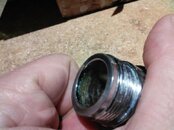Picked up a SP MK-10 (wanted the DIN that it had, and a G250 to boot). When I hooked it up, I could tell things were not right (despite a seller's claim he tested it and it was fine - long story, enough said). It's extruding silicone out under the SPEC band.
I'm tearing it down for a rebuild, but wondering what you guys use to best get all the god awful silicone out of these things before its off to the ultrasonic? Any "secrets" of a simple & effective method, or just tons of q-tips and paper towels?
I'm tearing it down for a rebuild, but wondering what you guys use to best get all the god awful silicone out of these things before its off to the ultrasonic? Any "secrets" of a simple & effective method, or just tons of q-tips and paper towels?





